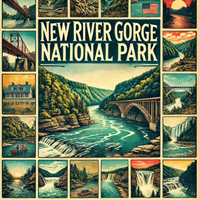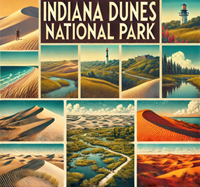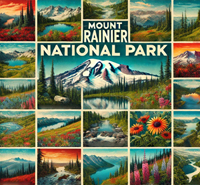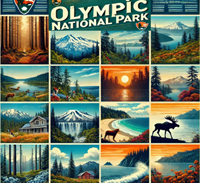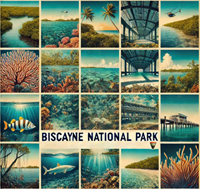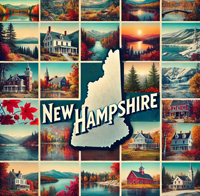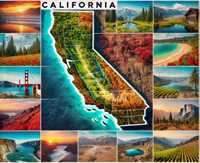
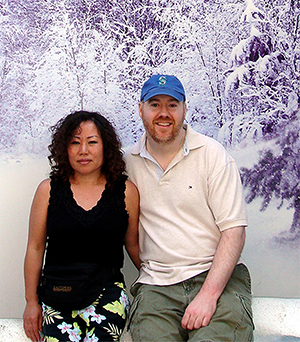
William and Hui Cha Stanek have meticulously crafted these national park guides, each showcasing the most stunning landscapes across the USA. But beyond the breathtaking scenery, these guides delve into the stories, experiences, and connections that make each park visit truly memorable.
National Parks Index | US Itineraries Index | American Roadtrips Index

Bring home a Bugville Critters book and watch as your child's love for reading and learning grows with every page. Hand-painted illustrations bring the heartwarming stories to life. Ask your librarian to add Bugville Critters to the library's digital collection today!
Discover William Stanek's Exclusive Art Collection
Explore and purchase the stunning art featured on this site. Own a piece of William Stanek's unique and captivating artwork today!
(May 2, 2025) Introducing Grand Canyon National Park: Arizona's Natural Wonder
Introduction to Grand Canyon National Park
The Grand Canyon is one of those places that defies description-- a vast, yawning chasm that seems to stretch into infinity. Standing on the rim for the first time, I was overwhelmed by its scale and the layers of color that change with the shifting light. It' s a place that demands respect and reflection. One of my most memorable experiences here was hiking down into the canyon, feeling the temperature rise with each step and the walls close in around me. It' s in these moments that you truly appreciate the grandeur of this natural wonder and the forces that have shaped it over millions of years.
How to Reach Grand Canyon National Park
From the North (Las Vegas, NV): Travelers can take US-93 south to Interstate 40 east, then follow AZ-64 north to the South Rim entrance. The distance is approximately 275 miles, with a travel time of around 4.5 hours.
From the South (Phoenix, AZ): Visitors from Phoenix can take Interstate 17 north to Flagstaff, then follow US-180 north to AZ-64 north to the South Rim entrance. This route covers about 230 miles and takes around 4 hours.
From the East (Albuquerque, NM): From Albuquerque, take Interstate 40 west to AZ-64 north to the South Rim entrance. This journey spans approximately 400 miles and takes around 6.5 hours.
From the West (Los Angeles, CA): Travelers from Los Angeles can take Interstate 15 north to Interstate 40 east, then follow AZ-64 north to the South Rim entrance. This route covers approximately 480 miles and takes around 8 hours.
Exploring Grand Canyon: Must-Visit Sites
- South Rim: Offers numerous viewpoints, including Mather Point and Yavapai Observation Station, and access to the Bright Angel Trail.
- North Rim: Provides a more secluded experience with stunning views from Bright Angel Point and the North Kaibab Trail.
- Havasu Falls: A beautiful waterfall located on the Havasupai Indian Reservation, accessible by a challenging hike.
- Grandview Point: Known for its panoramic views of the canyon.
Seasonal Variations
Grand Canyon's vast landscapes offer unique beauty year-round:
- Spring: Mild temperatures and blooming wildflowers create ideal conditions for hiking and photography.
- Summer: Warm temperatures and long daylight hours make for excellent exploration conditions, though crowds are larger.
- Fall: Cooler temperatures and fewer visitors create a peaceful environment, with vibrant fall foliage in some areas.
- Winter: Snow-covered landscapes offer a serene and picturesque setting, ideal for solitude and photography, though some areas may be inaccessible.
Visitor Updates for Grand Canyon National Park
Conservation Efforts
William Stanek's photography in Grand Canyon emphasizes the park's majestic beauty and the importance of preserving its natural landscapes. His work supports efforts to protect the park from the impacts of climate change, tourism, and human activity, advocating for the conservation of its unique geological formations and ecosystems.
1 Day at Grand Canyon National Park: Arizona's Natural Wonder
Introduction
Grand Canyon National Park, located in northern Arizona, is known for its immense size, stunning views, and geological significance. Here's a detailed guide to making the most of your visit, with expert tips from William and Hui Cha Stanek.
Morning: Sunrise and Rim Exploration
6:00 AM - Sunrise at Mather Point
- Overview: Start your day with a breathtaking sunrise at Mather Point, offering panoramic views of the canyon.
- Tips from William: Arrive early to set up your tripod and capture the sunrise over the canyon. Use a wide-angle lens to encompass the entire scene.
- Insights from Hui Cha: Dress warmly and bring a thermos of hot coffee or tea. The early morning canyon air can be chilly.
7:30 AM - Breakfast at El Tovar Hotel
- Overview: Head to the historic El Tovar Hotel for a quick breakfast with stunning views of the canyon.
- Tips from William: Capture the morning light on the hotel's historic architecture.
- Insights from Hui Cha: Enjoy a hearty breakfast to fuel your day. Grab some snacks and water for later.
Mid-Morning: Rim Drives and Short Hikes
8:30 AM - South Rim Trail
- Overview: Hike a section of the South Rim Trail, which offers stunning views of the canyon and its geological features.
- Tips from William: Use a wide-angle lens to capture the expansive views. The morning light is perfect for photography.
- Insights from Hui Cha: The trail is relatively easy and offers great photo opportunities. Wear comfortable shoes and bring a hat.
10:00 AM - Desert View Drive
- Overview: Drive along Desert View Drive, stopping at various overlooks for spectacular views of the canyon.
- Tips from William: Use a polarizing filter to reduce glare and enhance the colors of the landscape. Stop frequently to capture the stunning vistas.
- Insights from Hui Cha: Take your time and enjoy the drive. The road can be narrow and winding, so drive carefully.
Afternoon: Scenic Views and Wildlife Viewing
12:30 PM - Picnic Lunch at Desert View
- Overview: Enjoy a packed lunch at Desert View, with stunning views of the Colorado River and the canyon.
- Tips from William: Capture candid moments of your picnic with the beautiful canyon backdrop.
- Insights from Hui Cha: Pack a nutritious and energizing meal. Take a moment to relax and enjoy the natural surroundings.
1:30 PM - Grandview Point
- Overview: Visit Grandview Point, one of the most popular overlooks in the park, offering sweeping views of the canyon.
- Tips from William: Use a wide-angle lens to capture the expansive views. The afternoon light enhances the colors and details.
- Insights from Hui Cha: The area can be crowded, so be patient and respectful of other visitors. Bring plenty of water.
3:00 PM - Wildlife Viewing at Kaibab Forest
- Overview: Explore the Kaibab National Forest, known for its diverse wildlife, including elk, deer, and various bird species.
- Tips from William: Use a telephoto lens to capture the wildlife without disturbing them. The late afternoon light is ideal for photography.
- Insights from Hui Cha: Bring binoculars and be patient. The area is rich in wildlife, so take your time and enjoy the experience.
Late Afternoon: Photography and Relaxation
4:30 PM - Yavapai Point and Geology Museum
- Overview: Visit Yavapai Point and the Geology Museum for more stunning views of the canyon and insights into its geological history.
- Tips from William: Use a wide-angle lens to capture the dramatic cliffs and the serene canyon. Experiment with different compositions and perspectives.
- Insights from Hui Cha: The museum offers fascinating insights into the park's geological history. Take your time exploring the exhibits.
Evening: Sunset and Dinner
6:00 PM - Sunset at Hopi Point
- Overview: Head to Hopi Point for a stunning sunset view over the Grand Canyon.
- Tips from William: Use a graduated neutral density filter to balance the exposure. Experiment with long exposures to capture the changing light.
- Insights from Hui Cha: Arrive early to find a good spot. Bring a light jacket as it can get cool after sunset.
7:30 PM - Dinner in Grand Canyon Village
- Overview: Return to Grand Canyon Village for a relaxing dinner at a local restaurant.
- Tips from William: Capture the evening atmosphere of the village. Try some local Arizona cuisine to end your day.
- Insights from Hui Cha: Reflect on the day's adventures and enjoy a hearty meal. Grand Canyon Village offers a variety of dining options with a welcoming atmosphere.
Grand Canyon National Park (Arizona)
Grand Canyon National Park, located in northern Arizona, is one of the most iconic natural landmarks in the world. Covering over 1.2 million acres, the park features the awe-inspiring Grand Canyon, carved by the Colorado River over millions of years. Its vast landscapes, geological formations, and stunning vistas make it a top destination for photographers, hikers, and nature enthusiasts.
Park History and Cultural Significance:
- Established as a national park in 1919, Grand Canyon protects significant geological features and cultural resources.
- The area has been inhabited by Native American tribes, including the Havasupai, Hualapai, Navajo, and Hopi, for thousands of years. The park also preserves sites related to early European explorers and pioneers.
Visitor Centers and Facilities:
- South Rim Visitor Center: Offers exhibits on the park's natural and cultural history, a park film, maps, information, restrooms, and a gift shop.
- North Rim Visitor Center: Provides exhibits, maps, information, restrooms, and a gift shop, with stunning views of the canyon.
- Desert View Watchtower: Features a historic tower with panoramic views, exhibits, maps, information, restrooms, and a gift shop.
- Campgrounds: The park has several campgrounds, including Mather Campground (South Rim), North Rim Campground, and Desert View Campground, offering basic amenities like restrooms and picnic tables.
Best Times to Visit:
- Spring (March to May): Ideal for moderate temperatures and blooming wildflowers.
- Summer (June to August): Warm weather perfect for exploring the canyon, though it can be crowded.
- Fall (September to November): Cooler temperatures and fewer crowds make this a great time to visit, with beautiful fall foliage.
- Winter (December to February): Offers solitude and opportunities for winter activities, but temperatures can be cold, and the North Rim is closed.
Activities and Recreation:
- Hiking: Trails range from easy walks to challenging hikes, including the Bright Angel Trail, South Kaibab Trail, and Rim Trail.
- Mule Rides: Experience the canyon from a different perspective with guided mule rides to the canyon floor or along the rim.
- Wildlife Watching: Opportunities to see elk, mule deer, bighorn sheep, and a variety of bird species.
- Scenic Drives: The Desert View Drive and Hermit Road offer breathtaking views of the canyon and access to many trailheads and viewpoints.
- Rafting: The Colorado River offers exhilarating white-water rafting experiences through the Grand Canyon.
- Photography: The park's stunning landscapes provide endless opportunities for photography, particularly at sunrise and sunset.
Accessibility Information:
- The South Rim Visitor Center, North Rim Visitor Center, and Desert View Watchtower are wheelchair accessible.
- Accessible trails include the Rim Trail and the paved sections of the South Kaibab Trail.
- Accessible campgrounds and restrooms are available throughout the park.
Permits and Regulations:
- Entrance Fees: Required for entry; passes can be purchased online or at park entrances.
- Camping Permits: Required for camping at designated campgrounds. Reservations are recommended during peak seasons.
- Backcountry Permits: Required for overnight stays in backcountry areas.
- River Permits: Required for private rafting trips on the Colorado River.
- Special Use Permits: Needed for activities such as weddings, commercial filming, and large group gatherings.
Nearby: Wupatki National Monument, Sunset Crater Volcano National Monument
-
Wupatki National Monument: About an hour and a half from the Grand Canyon, this monument preserves numerous ancient pueblos and provides insights into the lives of the Native Americans who inhabited the area.
- Activities: Exploring ruins, ranger-led programs.
- Notable Sites: Wupatki Pueblo, Citadel Pueblo.
- Wildlife: Pronghorns, various reptiles, hawks.
-
Sunset Crater Volcano National Monument: Located about an hour and a half from the Grand Canyon, this monument features a cinder cone volcano and offers hiking trails through volcanic landscapes.
- Activities: Hiking, geology tours.
- Notable Trails: Lava Flow Trail, Lenox Crater Trail.
- Wildlife: Mule deer, jackrabbits, various bird species.
Important Updates for Grand Canyon National Park
Grand Canyon National Park (Arizona)
Local Attractions and Surrounding Areas:
Grand Canyon National Park, located in northern Arizona, is one of the most iconic natural landmarks in the United States, known for its immense size, stunning vistas, and rich geological history. The nearby town of Tusayan serves as the primary gateway to the South Rim, offering a variety of amenities including lodging, dining, and shops. Tusayan also features the Grand Canyon IMAX Theater, where visitors can watch a film about the history and geology of the canyon.
The city of Flagstaff, located about an hour and a half from the South Rim, provides additional amenities and attractions. Flagstaff is home to the Lowell Observatory, the Museum of Northern Arizona, and the historic downtown area, offering a variety of cultural and recreational activities. For those interested in Native American history, the nearby Wupatki National Monument and Walnut Canyon National Monument offer fascinating insights into the region's ancient cultures.
For visitors to the North Rim, the town of Kanab in southern Utah provides amenities and serves as a gateway to other nearby attractions such as Zion National Park and Bryce Canyon National Park.
Nearby Attractions:
Grand Canyon National Park is surrounded by numerous attractions that enhance the visitor experience. Here are some must-see local attractions:
-
Grand Canyon Village: The main hub of the South Rim, Grand Canyon Village offers lodging, dining, visitor centers, and access to popular viewpoints. Key attractions include the El Tovar Hotel, Hopi House, and Lookout Studio.
-
Yavapai Point and Geology Museum: Located near Grand Canyon Village, Yavapai Point offers one of the best panoramic views of the canyon. The adjacent Geology Museum provides insights into the canyon's geological history.
-
Desert View Watchtower: Located at the eastern end of the South Rim, this 70-foot stone watchtower offers spectacular views of the canyon and the Colorado River. The tower itself is a work of art, designed by architect Mary Colter.
-
Tusayan Ruin and Museum: Located near Desert View, this archaeological site provides a glimpse into the lives of the ancestral Puebloan people who once inhabited the area.
-
Havasu Falls: Located within the Havasupai Indian Reservation, Havasu Falls is a stunning waterfall known for its turquoise waters. It's a challenging hike but offers an unforgettable experience.
-
Lowell Observatory: Located in Flagstaff, this historic observatory offers stargazing programs and exhibits on astronomy.
Nearby Towns and Cities
Visitors to Grand Canyon National Park can find additional amenities and activities in nearby towns and cities:
-
Tusayan: Located just outside the South Rim entrance, Tusayan offers hotels, restaurants, and the Grand Canyon IMAX Theater.
-
Williams: Known as the "Gateway to the Grand Canyon," Williams is located about an hour south of the park. It offers accommodations, dining, and the Grand Canyon Railway.
-
Flagstaff: Located about 80 miles south of the park, Flagstaff offers a wide range of amenities, including hotels, restaurants, shopping, and attractions like the Lowell Observatory and the Museum of Northern Arizona.
-
Sedona: Known for its stunning red rock formations, Sedona is located about 120 miles south of the park. It offers luxury accommodations, fine dining, and outdoor activities like hiking and jeep tours.
-
Page: Located about 140 miles northeast of the park, Page offers access to Lake Powell, Antelope Canyon, and Horseshoe Bend.
Scenic Drives
Grand Canyon National Park boasts several scenic drives that offer unparalleled views of the park's unique landscapes. These drives are perfect for capturing the essence of the park through photography.
-
Desert View Drive:
- Details: This 25-mile scenic drive runs from Grand Canyon Village to Desert View, offering numerous viewpoints and access to several attractions.
- Key Stops: Highlights include Mather Point, Yaki Point, Grandview Point, Moran Point, and Desert View Watchtower.
- Photography Tips: William Stanek suggests stopping at the various viewpoints along the drive to capture different perspectives of the canyon. Early morning and late afternoon provide the best lighting for photography.
-
Hermit Road:
- Details: This 7-mile scenic drive runs from Grand Canyon Village to Hermits Rest, offering several viewpoints along the way. The road is closed to private vehicles during the peak season, with shuttle buses providing access.
- Key Stops: Highlights include Maricopa Point, Powell Point, Hopi Point, Mohave Point, and Pima Point.
- Photography Tips: Hui Cha Stanek recommends using a polarizing filter to reduce glare and enhance the vibrant colors of the canyon. The best times for photography are during the golden hours of sunrise and sunset.
-
Kaibab Plateau - North Rim Parkway (AZ-67):
- Details: Although primarily serving the North Rim, this scenic drive from Jacob Lake to the North Rim offers beautiful views of forests and meadows. It's a great route for those planning to visit both rims.
- Key Stops: Highlights include various overlooks and picnic areas along the way.
- Photography Tips: The Staneks suggest using a wide-angle lens to capture the expansive views along the drive. Early morning and late afternoon provide the best conditions for photography.
Reservations and Timed Entry Information
Click the link to see updates. Wait up to 30 seconds for results.
Best Hikes
Grand Canyon National Park offers a variety of hiking trails that cater to all skill levels. Each trail provides unique opportunities for exploration and photography. Here are some of the best hikes in the park:
-
Bright Angel Trail:
- Details: This iconic trail descends 9.5 miles from the South Rim to the Colorado River, offering stunning views of the canyon's inner depths. Hikers can choose shorter hikes to rest points like the 1.5 Mile Resthouse or Indian Garden.
- Key Viewpoints: Highlights include the views from Indian Garden, Plateau Point, and the Colorado River.
- Photography Tips: William Stanek recommends starting early in the morning to capture the best light and avoid the heat. A wide-angle lens is ideal for capturing the expansive views.
- Addition Notes: It's 12 miles round trip to Plateau Point. Bright Angel Trail is a challenging hike (for experienced hikers only) with stunning views of the Grand Canyon and the Colorado River. The trail features several rest houses and water stations. Key points of interest along the trail include the Indian Garden and Plateau Point. William recommends this hike for its dramatic scenery and the opportunity to experience the canyon's depths up close.
- Safety caution: The return hike is significantly more difficult than the descent. Plan for at least twice as much time to hike back up, and carry sufficient water and snacks. Many hikers have died on this trail; often, by underestimating summer heat or failing to note that a water source was broken or otherwise unavailable.
-
South Kaibab Trail:
- Details: This 7-mile trail descends from the South Rim to the Colorado River, offering panoramic views of the canyon. Highlights include Ooh Aah Point, Cedar Ridge, and Skeleton Point.
- Key Viewpoints: The best viewpoints are Ooh Aah Point, Cedar Ridge, and Skeleton Point.
- Photography Tips: Hui Cha Stanek suggests using a polarizing filter to enhance the colors of the canyon and sky. Early morning and late afternoon provide the best light for photography.
- Addition Notes: It's 6-miles round trip to Skeleton Point. South Kaibab Trail is moderately difficult and provides stunning panoramic views of the Grand Canyon. The trail features steep switchbacks and exposed ridges, offering breathtaking vistas along the way. Hui Cha suggests this hike for its scenic beauty and the chance to see the canyon's geological features from different angles.
- Safety caution: This trail has no water sources. Carry sufficient water, and be prepared for steep and exposed sections. Many hikers have died on this trail; often, by running out of water and/or underestimating summer heat.
-
Rim Trail:
- Details: This easy trail runs 13 miles along the South Rim from South Kaibab Trailhead to Hermits Rest. It offers numerous viewpoints and interpretive signs.
- Key Viewpoints: Highlights include Mather Point, Yavapai Point, and Hopi Point.
- Photography Tips: The Staneks recommend using a telephoto lens to capture distant views along the trail. The best light for photography is in the early morning or late afternoon.
-
Grandview Trail:
- Details: This challenging 12-mile round-trip trail descends from Grandview Point to Horseshoe Mesa, offering rugged terrain and stunning views of the canyon.
- Key Viewpoints: The best viewpoints are from Horseshoe Mesa and Cottonwood Creek.
- Photography Tips: William Stanek suggests using a wide-angle lens to capture the expansive views along the trail. Early morning and late afternoon provide the best light for photography.
-
Safety caution: The trail is very steep and can be challenging; ensure proper footwear and carry enough water.
-
Hermit Trail:
- Details: This 8.5-mile trail descends from Hermits Rest to the Colorado River, offering beautiful views of the canyon and access to Hermit Rapids.
- Key Viewpoints: The best viewpoints are Santa Maria Spring, Dripping Springs, and Hermit Rapids.
- Photography Tips: Hui Cha Stanek recommends using a telephoto lens to capture distant views and wildlife along the trail. Early morning and late afternoon provide the best light for photography.
- Safety caution: This trail is less maintained; be prepared for rough conditions and ensure you have ample supplies.
-
Tanner Trail:
- Details: This strenuous 9-mile trail descends from Lipan Point to the Colorado River, offering rugged terrain and stunning views of the canyon's eastern section.
- Key Viewpoints: The best viewpoints are from the Colorado River and the Eastern Grand Canyon.
- Photography Tips: The Staneks suggest using a wide-angle lens to capture the expansive views along the trail. Early morning and late afternoon provide the best light for photography.
-
Havasu Falls Trail:
- Details: This 10-mile trail leads to the stunning Havasu Falls, known for its turquoise waters. The trail requires a permit and offers an unforgettable experience. William suggests this hike for its scenic beauty and the opportunity to experience the unique landscape of the Havasupai Reservation.
- Key Viewpoints: The best viewpoints are from Havasu Falls, Mooney Falls, and Beaver Falls.
- Photography Tips: William Stanek recommends using a polarizing filter to enhance the colors of the water and sky. Early morning and late afternoon provide the best light for photography.
- Safety caution: Obtain necessary permits in advance and be prepared for challenging conditions and limited services.
William and Hui Cha Stanek's deep connection with Grand Canyon National Park is evident in their extensive body of work. William's technical prowess with cameras and lenses, combined with Hui Cha's artistic eye, creates a dynamic partnership that brings the park's beauty to life. They emphasize the importance of timing and light in landscape photography, often spending hours waiting for the perfect conditions to capture the essence of the Grand Canyon.
Their commitment to conservation is also a significant aspect of their work. Through their photography and writings, they strive to raise awareness about the importance of preserving natural landscapes like the Grand Canyon. They support organizations such as the National Park Foundation and the Sierra Club, advocating for responsible tourism and environmental stewardship.
Conclusion
Grand Canyon National Park, with its vast and stunning landscapes, offers endless opportunities for exploration and photography. The local attractions, scenic drives, and hiking trails provide a comprehensive experience for visitors. Through the lens of William and Hui Cha Stanek, the park's beauty and significance are captured and shared, inspiring others to appreciate and protect this natural wonder. Whether you are a seasoned photographer or a casual visitor, Grand Canyon National Park promises a memorable and enriching adventure.
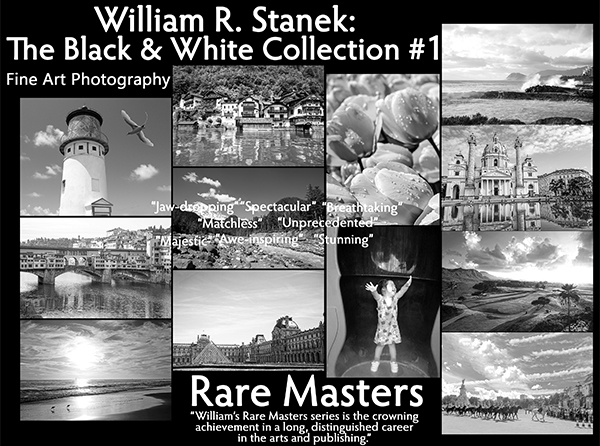
Step into a world of timeless beauty with our premium, oversized hardcover book - crafted for discerning collectors and anyone who values the power of art. Perfect for your coffee table, it's more than just a book; it's a conversation starter, a window into over 30 years of William's visionary photography.
Your Support Matters
Purchasing artwork from William Stanek's collection not only brings beauty into your life but also helps us continue to share. Thank you for supporting our creative journey!

Support The Lights of Paris by Robert Stanek, William Stanek's pen name! Through vivid historical detail and deeply moving character stories, Robert takes readers on an unforgettable journey through one of history’s most transformative times.


